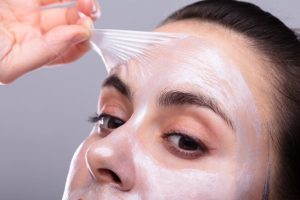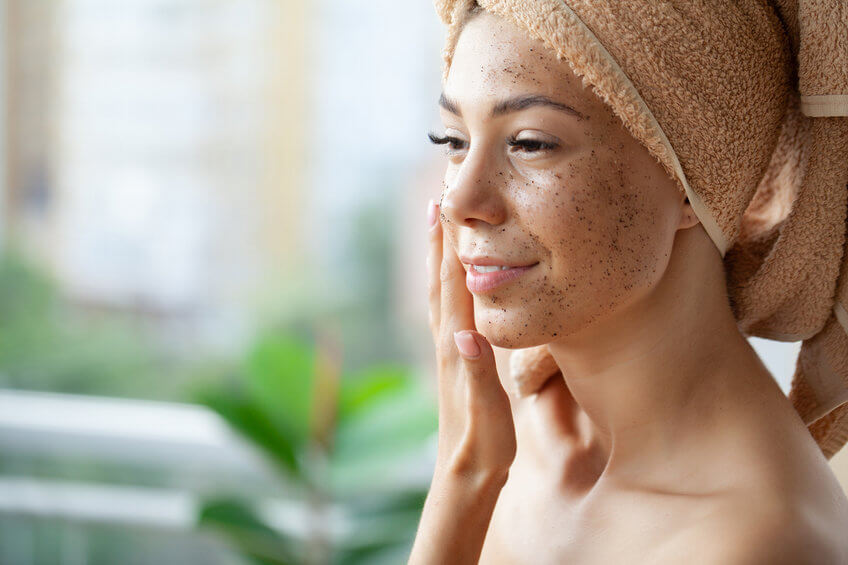Many beauty experts agree – exfoliation is key to a youthful, glowing complexion. And who doesn’t want that? If you aren’t regularly partaking in a face exfoliating process, it may be time to start. But how often should you exfoliate your face? Perhaps more frequently than you’d expect.
Read on for the skinny on face exfoliation.
What Is Exfoliation?
Exfoliation is the act of removing dead skin cells from the surface of your skin. Your skin cells are in a constant flux of dying and regenerating. Your skin naturally sheds dead cells to make room for new cells about every 30 days.
Sometimes, dead skin cells don’t fall off completely on their own – they hang on to the surface of your skin. This can result in clogged pores or dry, flaky skin. Exfoliation helps remove those dead skin cells to make room for the fresh, new cells underneath.1
What Are The Potential Benefits Of Exfoliating Your Face?
How does exfoliation benefit your complexion? Ahem, let us count the ways. There are many potential benefits to exfoliating your face, including:
- Exfoliation helps unclog pores by removing dry skin cells and other debris.
- This process may help ward off skin blemishes and ingrown hairs.
- Exfoliation may help other skin care products penetrate deeper into the skin.
- Long term exfoliation has been found to support collagen production. Collagen is a key to glowing, vibrant, firm-looking skin.
- Exfoliation may support a balanced skin tone and brighter-looking skin.2,3,4
Things To Consider When You Start Exfoliating Your Face
1. Choose Between A Physical And A Chemical Exfoliant
There are two general camps when it comes to exfoliation: physical and chemical. The method you choose will depend on the area you are exfoliating, your skin concerns, and your personal preference.
 All About Physical Exfoliants
All About Physical Exfoliants
Granular substances, like face scrubs, are physical exfoliants. Anything that scrubs your skin, like a loofah, skin brush, or even a washcloth, also counts as a physical exfoliant.
- One potential benefit of physical exfoliation is that it’s easy and doesn’t necessarily require special products. If you use a tool that exfoliates, like a cleansing brush, you can use your regular face wash to exfoliate. Simply rub it in with a brush or a washcloth.
- One drawback of physical exfoliation is that it could potentially cause micro-tears in your skin if you aren’t careful. To prevent this, stick with fine exfoliating particles. Avoid scrubs that contain large pieces of exfoliating material, like fruit pits or nut shells.5
What Are Good Physical Exfoliating Ingredients To Look For?
When evaluating physical exfoliants, look for ultra-fine particles, like elemental crystal powder. The idea is to gently buff out any dullness on your skin – not to scrape or damage your delicate skin. Materials like dry brushes and exfoliating mitts can help you turn virtually any product into an exfoliant.
All About Chemical Exfoliants
This method relies on compounds, like hydroxy acids, to break down and remove dead skin cells from the surface of your skin. They work by breaking down the bonds that hold dead skin cells together. This makes it easy to gently wipe them off of your face. Here are common active ingredients you will likely see in chemical exfoliants:
- Alpha hydroxy acids (AHAs) such as glycolic acid and lactic acid
- Beta hydroxy acids (BHAs) such as salicylic acid
- Fruit enzymes, like bromelain from pineapple and papain from papaya6,7,8
While the word “chemical” might sound harsh, this type of exfoliating can actually be quite gentle – even more gentle than physical exfoliants. Chemical exfoliators can be used for any skin concern, including oily or sensitive skin. Some ingredients, like fruit enzymes, may be gentler than others.9
What Are Good Chemical Exfoliating Ingredients To Look For?
 AHAs, BHAs, and fruit enzymes are all beloved by the skincare community. Here’s a rundown of many ingredients you may see in a chemical exfoliant, and what they may do for your skin:
AHAs, BHAs, and fruit enzymes are all beloved by the skincare community. Here’s a rundown of many ingredients you may see in a chemical exfoliant, and what they may do for your skin:
- AHA Complex: Promotes cellular renewal and turnover and supports the production of collagen.
- Glycolic Acid: Helps gently peel off the outer layer of dead skin cells. It may also lighten the appearance of dark spots.
- Lactic Acid: Helps with peeling and skin hydration.
- Phytic Acid: Offers both exfoliating and antioxidant benefits, like skin brightening.
- Tartaric Acid: May support firm and tone-looking skin.
- Pyruvic Acid: Supports healthy cell turnover and hydration.
- BHA Complex: Penetrates into the skin to remove dead skin cells from the surface.
- Salicylic Acid: Penetrates into your skin and works to dissolve skin cells that may be clogging your pores.10,11,12,13,14,15,16
Which Exfoliation Method Should You Choose?
Both types of exfoliators can get the job done, and it can be good to have both for different circumstances. Dermatologists may recommend a chemical exfoliant for your face, since they tend to be gentler than physical scrubs.17
Be sure to ask your doctor or dermatologist and do a patch test before you start using a new product.
2. Make A Plan For How Often You Will Exfoliate Your Face
Humans lose around 500 million skin cells a day.18 If they remain on the skin, it can look dull, patchy, and dry. That’s a large volume of dead skin potentially hanging on to your face. If you’ve historically only exfoliated once in a blue moon, it may be time to step up your exfoliation efforts.
How Often Should You Exfoliate Your Face?

Many skincare experts advise that you exfoliate your face two to three times per week.19 Now, the exact number of times that you exfoliate will depend on the type of product you are using and your skincare concerns.
If you plan to use gentle chemical exfoliants that contain AHAs, BHAs, or fruit enzymes, you may want to stick to that goal of 2-3 times a week. However, chemical exfoliators have a wide range of strengths – so make sure to check with your dermatologist.
If you plan to use physical exfoliation, like a facial scrub, you will likely want to stick to only once per week. Remember, some physical exfoliators can be harsh on the face – so look for a fine grain if you go this route.20
How Often Should You Exfoliate According To Common Skin Concerns*
While skin care experts tend to agree that 2-3 times per week is the sweet spot, different skin concerns or goals might alter this advice. Take note: rather than thinking of your skin as a certain “type,” it may help to focus on the concerns you currently have. Most people can (and will) experience dry skin, oily skin, sensitive skin, and mature skin all at different points in their lives.
So, whatever your current skin concerns are, there are a few guidelines that can help your face exfoliating process.However, everyone’s skin care needs and sensitivity levels are different – so always read the instruction labels carefully and check with your dermatologist before putting a new skin care routine into place.
Use the following tips as a general guideline.
Mature Skin
If you want to stimulate new skin cell growth and uncover younger-looking skin (great idea, by the way), you should exfoliate 2-3 times a week. Exfoliating is a powerful tool in your anti-aging arsenal, as it may also help support a more even skin tone and smooth the appearance of fine lines and wrinkles.21
 Oily Skin
Oily Skin
If you are currently dealing with oily skin, you can (and should) exfoliate often, up to 3 times per week. Chemical exfoliants, like salicylic acid, are particularly good for oily skin. This ingredient can penetrate your skin and dissolve skin cells that may potentially clog your pores.22,23
Blemish-Prone Skin
If you’re worried about blemishes and clogged pores, exfoliation may help. If you have active blemishes on your face, you should exfoliate up to 3 times a week with a gentle chemical exfoliant.24
Dry Skin
If your skin is often dry, you may be hesitant to exfoliate. But regular exfoliation can clear the way for your favorite moisturizer and serum to get in there and do their jobs. If you’re hesitant, start off exfoliating once a week and gradually increase to 2-3 times per week. Always follow up with a moisturizer to give your skin the hydration it needs.25
Sensitive Skin
If your skin is currently sensitive, you may want to avoid physical exfoliants that have a large grain to them. Gravitate to chemical exfoliants, especially ones that contain fruit enzymes, like papaya and pineapple. Even with sensitive skin, experts still recommend you exfoliate up to three times a week. If you’re concerned that your skin might react, do a patch test first and start slow.26
*It’s always worth talking to your dermatologist before you start any new skincare regime.
3. Exfoliate The Right Way
Once you’ve picked an exfoliant, and you’ve committed to trying it a few times a week, it’s time to nail the technique. The process isn’t complicated, but it’s worth remembering that you should try to use a gentle hand and let the product do the work.
Physical Exfoliation
- Start by cleansing your face with your favorite face wash.
 Use a high quality scrub with a fine grain, like crystal particles.
Use a high quality scrub with a fine grain, like crystal particles.- Scoop a bit of scrub out into the palm of your hand.
- Use gentle circular motions to rub the product onto your face.
- Rinse it off with lukewarm water.
- Dry your face by patting it with a clean towel.
- Follow it up with a high quality moisturizer.27
Chemical Exfoliation
- Cleanse your face.
- Use a quality chemical exfoliant, like glycolic acid peel pads or exfoliating masks.
- Follow the directions on the product label.
- If using peel pads, you’ll usually be instructed to gently swipe the product over your face and neck. If using a mask, you may apply it to your face and let it sit while the enzymes work on the skin.
- Gently dry your face and apply your favorite moisturizer.28
Slough It Off
If you aren’t doing it already, it may be time to try your hand at exfoliating that beautiful visage. Once you see the way your face glows after the face exfoliating process, you just may find yourself hooked. If you’re hooked, don’t worry – you can do it up to three times a week. Again, talk with your dermatologist about the type and frequency of exfoliation that is right for you.
Learn More:
How To Exfoliate Your Lips The Right Way: DIY Lip Scrub
Exfoliation 101: What You Should Know About AHAs And BHAs In Your Skin Care Products
Skin Care Tips: How To Hydrate Skin
Sources
1. https://www.healthline.com/health/beauty-skin-care/meaning-of-exfoliating
2. https://www.byrdie.com/benefits-of-exfoliating
3. https://www.ncbi.nlm.nih.gov/pmc/articles/PMC4720453/
4. https://www.healthline.com/health/beauty-skin-care/meaning-of-exfoliating#benefits
5. https://intothegloss.com/2016/10/physical-exfoliation-vs-chemical-exfoliation/
6. https://www.ncbi.nlm.nih.gov/pmc/articles/PMC3047947/
7. https://www.fda.gov/cosmetics/cosmetic-ingredients/beta-hydroxy-acids
8. https://www.beautifulwithbrains.com/the-complete-guide-to-enzyme-exfoliants/
9. https://www.instyle.com/beauty/how-to-exfoliate
10. https://beverlyhillsmd.com/product/resurface-restore-youth-revealing-system/
11. https://www.healthline.com/health/beauty-skin-care/alpha-hydroxy-acid#_noHeaderPrefixedContent
12. https://www.fda.gov/cosmetics/cosmetic-ingredients/alpha-hydroxy-acids
13. https://www.byrdie.com/phytic-acid-skincare-4771912
14. https://www.nature.com/articles/s41598-020-69530-w
15. https://www.fda.gov/cosmetics/cosmetic-ingredients/beta-hydroxy-acids
16. https://www.healthline.com/health/skin/salicylic-acid-for-acne
17. https://www.gq.com/story/chemical-exfoliants
18. https://www.acs.org/content/acs/en/pressroom/newsreleases/2011/may/the-skinny-on-how-shed-skin-reduces-indoor-air-pollution.html
19. https://www.byrdie.com/how-often-should-i-exfoliate-my-face
20. https://www.healthline.com/health/beauty-skin-care/how-often-should-you-exfoliate-your-face#average-frequency
21. https://www.whowhatwear.com/best-face-exfoliators-for-mature-skin/slide10
22. https://www.byrdie.com/the-best-way-to-exfoliate-according-to-your-skin-type-4137168
23. https://www.healthline.com/health/skin/salicylic-acid-for-acne
24. https://www.bustle.com/p/is-exfoliation-good-for-acne-according-to-the-experts-the-answer-isnt-a-simple-one-13208977
25. https://www.instyle.com/beauty/how-to-exfoliate-dry-skin
26. https://www.allure.com/gallery/best-chemical-exfoliants-sensitive-skin
27. https://www.womenshealthmag.com/beauty/a19775624/how-to-exfoliate-face/
28. https://www.womenshealthmag.com/beauty/a19775624/how-to-exfoliate-face/
























































